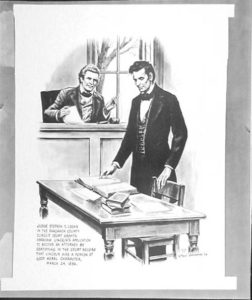By Blake Harris
To honor both Lincoln’s noble profession — July was lawyer month at the Cottage — and our 10-year anniversary, we created a list of Ten Things You Might Not Have Known about Lincoln the Lawyer.
1) Lincoln represented a slave owner
In October 1847 Robert Matson brought several enslaved people from Kentucky to work on his farm in Illinois, including Jane Bryant and her four children. Also working at the farm was freedman Anthony Bryant, Jane’s husband. When threatened with the children being sold, the Bryants fled Matson’s farm and sought the protection of local abolitionists Gideon M. Ashmore and Hiram Rutherford. Lincoln represented Matson, arguing that although a free state Illinois reserved protections for slave ownership as long as the slaves were in transit. Lincoln lost this case and the slaves were freed. Read more about the case here.
2) Lincoln had to sue for a fee
Lincoln worked his most profitable case while representing Illinois Central Railroad in 1856 who paid him $5,000. McLean County had seized railroad land to sell after refusing to recognize the state’s authority to exempt the company from county taxes. The case went before the Illinois state supreme court and was decided in favor of Illinois Central Railroad. More than a year after the victory, and after Lincoln sued the company twice for his fee, he was finally paid.
3) Lincoln fought the sale of an African American woman
In 1841 Lincoln represented Nance Legins-Costley, an African American woman who had been sold. He argued that the sale of people in Illinois was illegal due to Illinois’ status as a free state. Lincoln won the case and Nance was freed from her position. Read more about the case here.
4) Lincoln had three law prtners
Over the course of his career as a lawyer, Lincoln had three separate law partners: John Stuart, Stephen Logan, and William Herndon. Lincoln shared an office with each of these partners in Springfield, Illinois. Click here for a brief summary of his law career.
5) Lincoln did not go to Law School
Lincoln’s career in law began as a hobby of visiting courthouses to hear examples of great oratory discourse. Before long he began reading law books and in 1836 he passed an oral exam conducted by a panel of lawyers and received his law license. Although he was often criticized for a lack of technical knowledge, Lincoln pursued his cases with diligence, for which he was often rewarded. Read more about Lincoln’s training as a lawyer.
6) Lincoln lost his only U.S. Supreme Court case
Lincoln made many appearances as a lawyer in front of the Illinois Supreme Court but only one before the United States Supreme Court. In 1849 Lincoln represented Thomas Lewis before the Supreme Court in the case Lewis v Lewis. Lincoln lost the cause and Chief Justice Roger Taney wrote the majority opinion opposing Lincoln. Lincoln would cross paths with Taney again in 1861 when Taney administered Lincoln’s presidential oath of office.
7) Lincoln used the Moon as evidence
In 1858, Lincoln successfully defended his client who had been accused of murder in one of his most famous trials, dubbed the Almanac Trial. The key witness’s testimony relied on his explanation that he had seen the murder because of the light from the full moon. Lincoln was able to refute the claim through reference to a farmers almanac that showed there was a new moon the night of the murder, and thus insufficient light by which the witness could have seen the alleged murderer.
8) Lincoln and Jefferson Davis were adversaries on a case
In 1857 Lincoln was hired to represent the Rock Island Bridge Company which had been sued after a steamboat crashed into a recently constructed bridge. But the case had much larger implications: the bridge in question had made a transnational railroad route through the North possible. In fact, many southerners, including Secretary of War Jefferson Davis, preferred a southern railroad route and fought the Rock Island bridge location for years. Lincoln helped the Rock Island Bridge Company win their case and the bridge was rebuilt.
9) Lincoln told a defendant of his to vote for his prosecutor
In 1859 Lincoln represented Simeon Quinn Harrison, nicknamed Peachy. Peachy had killed a man in self-defense and was charged with murder, a local case that gained national attention due to Lincoln’s status as a presidential hopeful. In the last murder case of his 25-year career as a trial lawyer, Lincoln argued the case flawlessly and Peachy was acquitted. Read more about the case here.
After the case ended, Peachy wrote a letter to Lincoln, asking if he should vote for the prosecutor in this case, John M. Palmer, in an upcoming election. In a letter, dated November 3, 1859, Lincoln responded to Harrison by encouraging him to vote for Palmer, since “he is good and true, and deserves the best vote we can give him.” This month, we’re honored to display this original letter, on loan from Jorge Roldan and Family.
10) Lincoln planned to continue his law career after the presidency
Even after his election in 1860 Lincoln did not plan to give up on his career as a lawyer. Just before he moved to Washington, Lincoln told his law partner William Herndon to keep the sign up on their office, as he planned to return once his time as president was over.
Blake Harris is a Museum Program Associate at President Lincoln’s Cottage

